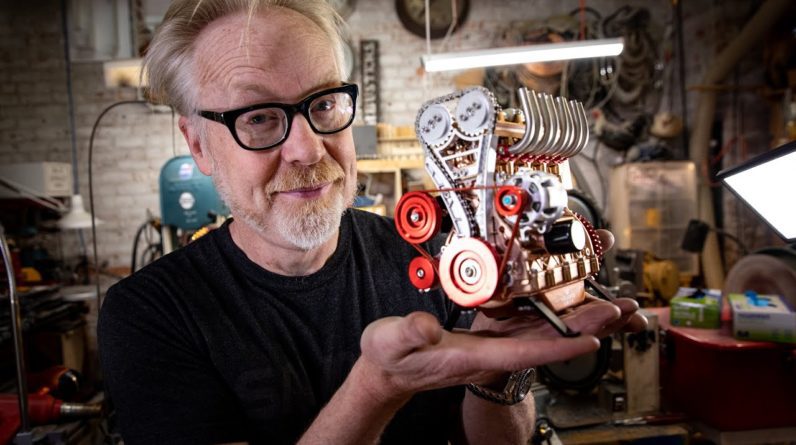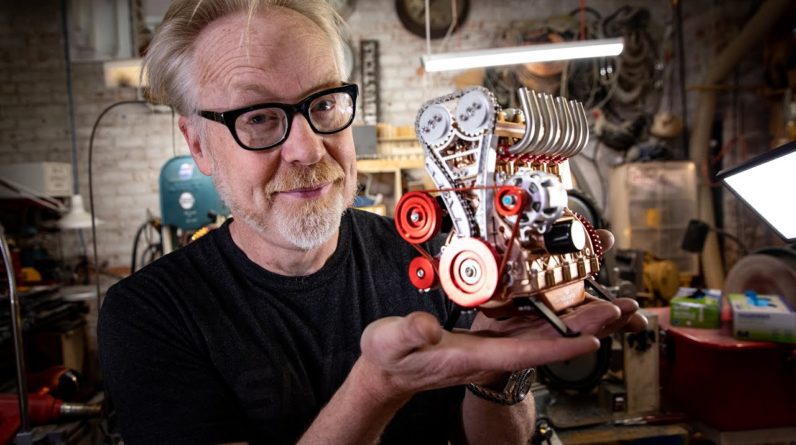hey everybody its norm from Tested and
French contesta we're here at Maker Faire 2017 and got in before the doors
open we're got crazy we're drawn to this
booth these are 3d printed car engines amazing and they're designed by this
gentleman here Eric how you doing Eric tell us how this project got started how
long you've been making this and your whole process of making these engines
about three years ago I was rebuilding a Toyota engine my garage and you know I
had a 3d printer and the only thing available was only like trinkets and
knickknacks online for people to download I figured hey I can model this
up in the computer and you know make it printable and make it you know moving
and running and share with everybody so they can have something to download and
see how an engine works on the inside and you know transition from like 3d
printing says automotive the mechanical it was kind of like a cool version of
those model kits you be able to get they were there clear energy yeah I always
wanted one as a kid and that was one of the inspirations to you know I can just
make my own so you have a bunch of different kinds of engines like is there
like a rhyme or reason which well I had to say own engine in my garage and I was
rebuilding that and then my friend had a Subaru WRX engine just laying around so
I took that and reverse engineered it and then the newer ones were done from
some CAD files and drawings and then the most recent one was done by just specs
and pictures and that was that was the challenging part was doing it from just
effects and pictures I'm having no dimensions or any
we chat with people who make replicas you know items all the time whether
they're movie props or mechanical things when engine is a very fairly complex
piece of machinery it what's your design process like your reference you said
it's from real engines the schematics but how do you start designing this it's
not just Sketchup there thank you I just jump into it and it's I visualize it in
my head I can see some of the moving parts and I can put that in the computer
and it's just I don't know how to explain it that well but this is how I
work and because there are parts that you start with like like the camshaft or
I start with the engine block yeah and then I came from specs and dimensions I
can start with the stroke and the bore and then designs it from there to start
to do a crankshaft into the kits and connecting rods and I built my work my
way out and then as building in the computer it allowed me to do the whole
assembly piece by piece and then have a full almost full functioning model in
the computer how much of it are each engines 3d printed parts versus hardware
I see some other hardware you have to bring in it maybe like two or three
percent hardware it's diff metric fasteners and springs and bearings but
it's mostly printed so in tolerances looks like that's a pretty tight the
first ones we're pretty tight but I designed all my parts to be printed on
just the cheapest printer I can find so anybody can print it you know anybody
can download the files and print their own so to help the tolerances are loose
where they can be and they're tight words they need to be so there's like
some people need to do finishing work and stuff but I've learned through the
process that what I can design tolerance revise wise to make things easier for
people that print on their own you're going to try honing out the cylinders
and putting a ring in the piston I thought about doing more like you know
leaving a piston and maybe doing them like an ethanol engine or something but
that's more more work and more time you could probably get a low temperature I
would trying to return the lowest burning fuel but yeah anything is going
to burn in the got a print in nylon and all that stuff
and that's one more project – one more camel worms open up that I'm not sure if
I want to tackle so these dentures all run off the motor on the outside they
actually run them what does this come and looks like you have a dial here
adjust speed it was just a small gear DP motor hooked up to a pulse width
modulation controller to a 12 volt power supply it allows you to just turn it
down and up so you can see me flow down you see the valves actually moving and
in sync with the Pistons are you also modeling the pathways for the coolest to
flow through now no pathways oh okay I can but it's it's more time you know and
then when you get into the cool jackets and the oil plastic engine you're making
thinner walls that some speed repairs can't sprint and they'll just end up
with gaps and you can make it clear and then you could put coolant through it
yeah yeah I mean the possibilities are endless you can just take it wherever
you want to go so I think it's cool though and you're designing basically a
lot of these there's fpm prints oh you also experiment with different types
some companies have taken like the Subaru engine and they printed it on
poly jets and stuff and that really stayed pretty Molly Jessica like words
like this look like a clear acrylic piece and you can see everything moving
but yeah I don't have access to those printers so but some people have tried
it now the transmissions that you have like transmissions are in my brain like
a complicated yet and like one reason why I kept doing it because I can't
explain how a transmission works or somebody you just can't like verbally
verbally explain it yeah it's impossible so if you download the file then you
assemble if your own you will know exactly how it works how to get the
gears and cogs move and lock and everything it'll make sense
have you gotten into an automatic transmission yet I want to but it's hard
to the planetary gearset and you can do it but then you wouldn't
be able to see the planetary gearset clear and you wouldn't be able to see
like the clutch back moving yeah so and I can't print and clear to where it's
you know visible gotcha I want to it's just
and these because they're decisional files you can put them at any any scale
scale you like or what started at about third scale to that were my printer
cable and then that just worked out that with a good scale so I kept going
everything its third about third scale it's thirty five percent of the real
what's the smallest you've gotten an engine to work in print
I haven't scaled it down below 35 per can because that's where my bearings are
I sized them for the bearings and you know I people have printed smaller but
they have gone out and source their own bearings and modify the file now do you
think you could take a classic engine like this and maybe do like a lost wax
kind of cat on you you could lost feel like ass yeah but you know one more
project and one more thing to but to recreate a classic engine that they
don't make those engine block for any re I mean this would be hardware picking
one the flathead because the cores in it would be perfect in it for lost wax but
yeah it's just one more thing if anybody wants to do it the files will be
uploaded and they can you know they can tackle that on their own awesome well
thank you so much here for sharing with us your 3d printed engine designed and
like you said these are all available online and little bit more on
Thingiverse the newer ones aren't online yet but they will be eventually and
what's next for you going on three years what's the next challenge you're going
to keep on making more engines and traditions I'm trying to find something
more complicated rotary engine rotary is next yeah rotary is like a two rotor
engines X 4 engines next um but I'm trying to find more complicated things
to the model in print so engines are so far the most complex tank engines and
transmissions cool awesome thank you so much
let's meet you thank you






